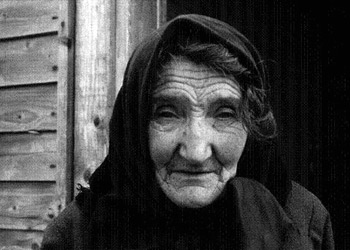Dorota Lampart – A Portrait of a Naive Artist
Since it was back in 1998 that the Polish Post decided to issue a series of four postal stamps in honour of Nikifor, the legendary illiterate painter, it seems that the time is ripe for a better recognition of the nation’s folk art. Although the most fervent of philatelists have not yet had the opportunity to enlarge their collections with stamps dedicated to her art, the temporary exhibition “A Patch of Sky” at Krakow’s Ethnographic Museum provides a rare glimpse into the life and works of Dorota Lampart (1906-2005).
Her pen-pals and neighbours in the village of Zawoja helped Dorota in different ways, constantly trying to make her solitude and poverty more bearable. In 1980 she received a prize of 10,000 złoty from the communist government. Most probably she used part of this money to buy herself cheap watercolours and golden paper. It can hardly be said that she was neglected by society, but the same cannot be said about her works, which are still waiting to find a rightful place in the history of naïve art.
After all, it was Dorota’s own choice to spend all of her life in isolation among the four wooden walls of her home in the countryside of Lesser Poland. She didn’t even take care of her two creaking houses that started to collapse when she was in her eighties. Dorota used to treat her animals with tenderness, refusing to kill her chickens so that they could grow old with her. She was the kind of fierce and hard-working countrywoman that is becoming an increasingly rare phenomenon in post-industrial Poland, at the same time being a true and delicate artist.
Unlike Nikifor, who moved around the Kryniczanka Valley in search of suggestive landscapes, Dorota seldom left her termite-eaten house. Every day she had to struggle to survive without proper heating or hot water. Farm labour did not allow her to entertain the idea of travelling for pleasure. Even the neighbouring region of Silesia was a kind of a promised land to Dorota that she never saw with her own eyes.
Letting her imagination run freely, Dorota managed to create a bucolic and primitive colouring book full of folk religious icons and other historical figures, only using a limited range of tempera shades. Her rough-sketched saints and unfinished icons convey a specific sense of rapture without displaying any kind of suffering. This is particularly true when her later works depicting Christ on the cross and Michael the archangel are taken into account.
The monumental but gawky figures constituting the cycle “Stations of the Cross” created in 1945 leave us with no doubt that Dorota Lampart was an unschooled artist who did not attend any courses of human anatomy. Yet her primitive style is able to express immense spirituality. The few landscapes that she drew from postcards, such as St. Sophia Cathedral (1975) are very minimalist in comparison with Nikifor’s elaborate panoramas.
Apart from piety, which shaped her vision of art and life, she accorded great importance to her dreams, which were often later given an aesthetic form. Most of her best works were conceived during her sleep after a day of hard work on the farm. Dream (1967), depicting a group of headless saints wearing richly embroidered robes, clearly displays her unique faculties of painting dream-inspired images.
Taking a closer look at Dorota’s lavish masterwork Sky (1939), a paper collage of visions decorated with metal foil, visitors do not have to believe in any god to appreciate the primitive but modern spirituality of her work.
“A Patch of Sky” (Wyrwany Skrawek Nieba, lit. “A Snatched Scrap of Heaven”) is showing until 16 May at the Esterka branch of the Ethnographic Museum, ul. Krakowska 46

